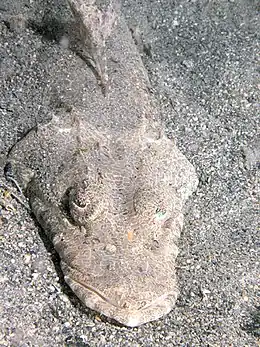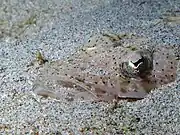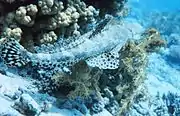Platycephalidae
The Platycephalidae are a family of marine fish, most commonly referred to as flatheads. They are relatives of the popular lionfish, belonging to the order Scorpaeniformes.
| Platycephalidae | |
|---|---|
 | |
| Sunagocia otaitensis | |
| Scientific classification | |
| Domain: | Eukaryota |
| Kingdom: | Animalia |
| Phylum: | Chordata |
| Class: | Actinopterygii |
| Order: | Scorpaeniformes |
| Suborder: | Platycephaloidei |
| Family: | Platycephalidae Swainson, 1839[1] |
| Genera[2] | |
Taxonomy
Platycephalidae was first proposed as a family in 1839 by the English naturalist William John Swainson.[1] The 5th edition of Fishes of the World classifies this family within the suborder Platycephaloidei in the order Scorpaeniformes.[3] Other authorities differ and do not consider the Scorpaeniformes to be a valid order because the Perciformes is not monophyletic without the taxa within the Scorpaeniformes being included within it. These authorities consider the Platycephalidae to belong to the suborder Platycephaloidei, along with the families Bembridae, Parabembridae, Hoplichthyidae and Plectrogeniidae within the Perciformes.[4]
Genera
Platycephalidae has the following genera classified within it:[2]
- Ambiserrula Imamura, 1996
- Cociella Whitley, 1940
- Cymbacephalus Fowler, 1938
- Elates D. S. Jordan & Seale, 1907
- Grammoplites Fowler, 1904
- Inegocia D. S. Jordan & W. F.Thompson, 1913
- Insidiator D. S. Jordan & Snyder, 1900
- Kumococius Matsubara & Ochiai, 1955
- Leviprora Whitley, 1931
- Onigocia D. S. Jordan & W. F. Thompson, 1913
- Papilloculiceps Fowler & Steinitz, 1956
- Platycephalus Bloch, 1795
- Ratabulus D. S. Jordan & Hubbs, 1925
- Rogadius D. S. Jordan & Richardson, 1908
- Solitas Imamura, 1996
- Sunagocia Imamura, 2003
- Thysanophrys Ogilby, 1898
Platycephalidae has been divided into as many as 5 subfamilies by some authors but Fishes of the World does not recognise subfamilies but does state that some authors recognise two subfamilies.[3] The two subfamilies are Platycephalalinae, containing Elates and Platycephalus, and Onigociinae, containing the remaining genera.[5] These two groupings are thought to have become divergent in the Eocene with the Platycephalinae being predominantly temperate and Onigociinae, being predominantly tropical. The basal Platycephalinae species are confined to southern Australia and the more derived taxa have diversified in the tropical Indo-West Pacific.[6]
The genus Sorsogona is recognised by Fishbase but, apparently, it does not include the type species, Sorsogona serrulata, as a species within it.[7] Catalog of Fishes treats this genus as a synonym of Rogadius but classifies all the species in Ratabulus, including the type species, which it treats as a synonym of Ratabulus tuberculatus.[8][9]
Description
Platycephalids are small to medium-sized fish. Most species are small, reaching an average of 10 cm in length. However, a few species in the genus Platycephalus are known to grow up to over a 1 m (3 ft 3 in) in length.[11] Their most distinctive characteristic is the flattened shape of their heads. While the rest of their bodies is shaped similarly to other fish that inhabit the areas they frequent, their heads are triangle-shaped and dorsoventrally depressed, giving them the shape of a trowel or an artist's spatula.[12] Their eyes are situated on the upper surface, in accordance with their bottom-dwelling lifestyle. They possess two complete dorsal fins, the first one supported by six to 9 strong spines.
Distribution and habitat
Platycephalidae can be found naturally in coastal waters throughout the Indo-Pacific.[3] A few species have been caught in the eastern Mediterranean, having traveled there from the Red Sea through the Suez Canal.[13]
Biology
Flatheads are mostly marine demersal fish, often resting directly on the seabed, sometimes partially buried in sand or mud. They can be found in a wide range of depths, ranging from 10 m to the edge of the continental shelf at depths of about 300 m (980 ft).[12]
Flatheads are carnivorous, feeding on small fish and crustaceans. They lie in wait buried by sand, with only their eyes poking out from the substrate. When prospective prey walks or swims close to the platycephalid's head, the flathead strikes rapidly, engulfing the prey in its large mouth. As flatheads are ambush predators they are expected to be relatively sedentary and not move large distances as adults. However, recent research has shown that part of the population of some flathead species makes long distance movements or spawning migrations.[14][15]
Fisheries
Active commercial fisheries are geared towards members of the family. In Japan, some species are the subject of experimental aquaculture programs. Flatheads are commonly caught on rod and line.[16] The larger species are considered game fish.
See also
References
- Richard van der Laan; William N. Eschmeyer & Ronald Fricke (2014). "Family-group names of Recent fishes". Zootaxa. 3882 (2): 001–230. doi:10.11646/zootaxa.3882.1.1. PMID 25543675.
- Eschmeyer, William N.; Fricke, Ron & van der Laan, Richard (eds.). "Genera in the family Platycephalidae". Catalog of Fishes. California Academy of Sciences. Retrieved 2 July 2022.
- J. S. Nelson; T. C. Grande; M. V. H. Wilson (2016). Fishes of the World (5th ed.). Wiley. pp. 467–495. ISBN 978-1-118-34233-6.
- Ricardo Betancur-R; Edward O. Wiley; Gloria Arratia; et al. (2017). "Phylogenetic classification of bony fishes". BMC Evolutionary Biology. 17 (162): 162. doi:10.1186/s12862-017-0958-3. PMC 5501477. PMID 28683774.
- Hisashi Inamura (1996). "Phylogeny of the Family Platycephalidae and Related Taxa (Pisces: Scorpaeniformes)". Species Diversity. 1: 123–233.
- Melody Puckridge; Peter R. Last; Daniel C. Gledhill; Nikos Andreakis (2019). "From the tropics to the pole and back again: Radiation in the flathead fishes (Platycephalidae) across Australia and the Indo-West Pacific". Journal of Biogeography. 46 (4): 680–693. doi:10.1111/jbi.13484.
- Froese, Rainer and Pauly, Daniel, eds. (2022). Species of Sorsogona in FishBase. February 2022 version.
- Eschmeyer, William N.; Fricke, Ron & van der Laan, Richard (eds.). "Genera in the family Platycephalidae". Catalog of Fishes. California Academy of Sciences. Retrieved 20 July 2020.
- Eschmeyer, William N.; Fricke, Ron & van der Laan, Richard (eds.). "Species in the genus Sorsogona". Catalog of Fishes. California Academy of Sciences. Retrieved 20 July 2022.
- Christopher Scharpf & Kenneth J. Lazara, eds. (7 December 2021). "Order Perciformes (Part 11): Suborder Platycephaloidei: Families Bembridae, Parabembridae, Hoplichthyidae, Platycephalidae and Plectrogeniidae". The ETYFish Project Fish Name Etymology Database. Christopher Scharpf and Kenneth J. Lazara. Retrieved 3 July 2022.
- IMAMURA, HISASHI (6 January 2015). "Taxonomic revision of the flathead fish genus Platycephalus Bloch, 1785 (Teleostei: Platycephalidae) from Australia, with description of a new species". Zootaxa. 3904 (2): 151–207. doi:10.11646/zootaxa.3904.2.1. PMID 25660779.
- Eschmeyer, William N. (1998). Paxton, J.R.; Eschmeyer, W.N. (eds.). Encyclopedia of Fishes. San Diego: Academic Press. p. 177. ISBN 0-12-547665-5.
- Hussein C; Ibrahim A, Alshawy F; Ahmad AA (2021). "First confirmed record of the Bartail flathead Platycephalus indicus (L.; 1758) (Actinopterygii:Platycephalidae) in the Syrian marine waters (Eastern Mediterranean)". Species. 22 (69): 161–165.
- Fetterplace, Lachlan C.; Davis, Andrew R.; Neilson, Joseph M.; Taylor, Matthew D.; Knott, Nathan A. (28 July 2016). "Active acoustic tracking suggests that soft sediment fishes can show site attachment: a preliminary assessment of the movement patterns of the blue-spotted flathead (Platycephalus caeruleopunctatus)". Animal Biotelemetry. 4 (1). doi:10.1186/s40317-016-0107-6.
- Hindell, Jeremy S. (29 July 2015). Gippsland Lakes dusky flathead tracking project. ISBN 978-1-74208-860-0. Retrieved 15 December 2017.
{{cite book}}:|website=ignored (help) - Stewart, J (2015). "STATUS OF FISHERIES RESOURCES IN NSW 2013-14". NSW Fisheries Reports: 391. Retrieved 15 December 2017.
- "Platycephalidae". Integrated Taxonomic Information System. Retrieved 21 February 2007.
- Myers, P.; R. Espinosa; C. S. Parr; T. Jones; G. S. Hammond; T. A. Dewey (2006). "Platycephalidae". Animal Diversity Web. University of Michigan Museum of Zoology. Retrieved 2007-02-21.
External links
 Data related to Platycephalidae at Wikispecies
Data related to Platycephalidae at Wikispecies- Photos of several species of Crocodilefishes




